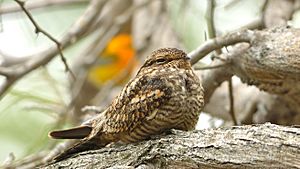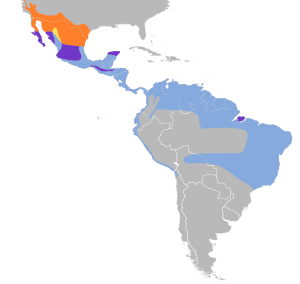Lesser nighthawk facts for kids
Quick facts for kids Lesser nighthawk |
|
|---|---|
 |
|
 |
|
| Conservation status | |
| Scientific classification | |
| Genus: |
Chordeiles
|
| Species: |
acutipennis
|
 |
|
The lesser nighthawk (Chordeiles acutipennis) is a fascinating bird. It is a type of nightjar and can be found across a large part of North, Central, and South America. These birds are known for being active mostly at dawn and dusk.
Contents
What Does a Lesser Nighthawk Look Like?
Adult lesser nighthawks have dark feathers. Their upper parts and chest show patterns of brown, grey, and white. Their long upper wings are black. When they fly, you can see a clear white bar on their wings.
Their tail is dark with white stripes. The feathers on their belly are a light yellowish-brown. These also have thin black stripes going across. Male lesser nighthawks have a white throat. Females have a light brown throat.
This bird looks a bit like the common nighthawk. However, the lesser nighthawk is a little smaller. Its tail is not as deeply forked. It also has more of a buffy, or yellowish-brown, color.
Unique Sounds and Calls
Lesser nighthawks make a very different sound from common nighthawks. They have a fast, low, whistling trill. This melodious sound can last for several seconds. You usually hear this call only when they are in their breeding areas.
Habitat and Reproduction
Lesser nighthawks live in open areas. Their breeding grounds stretch from the Southwestern United States through Central America to tropical South America. They often choose to nest on bare ground. Sometimes, they pick slightly raised spots like tree stumps, large rocks, or even flat roofs of houses.
They do not build a nest. Instead, the female lays two eggs directly on the bare ground. The female does most of the incubating, which means sitting on the eggs to keep them warm. This takes about 20 days. The young birds are ready to fly, or "fledge," when they are around 20 days old.
Protecting Their Young
If an adult lesser nighthawk is disturbed near its nest, it might try to trick the intruder. It may fly around to distract them. Sometimes, they even attack from the air to protect their nest.
Young birds have a special way to defend themselves. They might open their mouths wide and spread their wings. This makes them look bigger and more threatening than they are. After this display, they usually run away quickly.
Migration and Diet
Lesser nighthawks are partial migrants. This means they move to warmer places for part of the year. They leave the United States and northern Mexico during the winter months. Occasionally, a few birds might stay behind. Sometimes, they are seen in US Gulf Coast states, including Florida, as they travel.
These birds are skilled hunters. They catch flying insects while in the air. They mostly hunt near dawn and dusk, which is called being crepuscular. Sometimes, they hunt at night, especially when there is a full moon. They also like to hunt near street lights, where insects gather.
See also
 In Spanish: Añapero garrapena para niños
In Spanish: Añapero garrapena para niños


